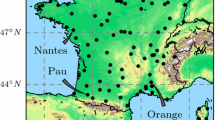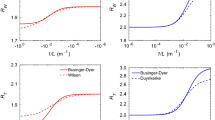Abstract
We provide general forms for long-term mean wind profiles from similarity-based wind profiles, beginning with a probabilistic adaptation of Monin–Obukhov similarity theory. We develop an analytical formulation for the stability distributions prevailing in the atmospheric surface layer, which in turn facilitates the derivation of a long-term mean wind profile based on Monin–Obukhov similarity theory. The modelled stability distributions exhibit good agreement with measurements from sites having different local conditions. The long-term wind profile formulation is further extended to include the influence of the depth of the atmospheric boundary layer (h), which becomes relevant for heights above h/3, and the resultant long-term ‘tall’ profile form also matches observations.
Similar content being viewed by others
References
Beljaars ACM, Bosveld FC (1997) Cabauw data for the validation of land surface parametrization schemes. J Clim 10: 1172–1193
Bershadskii A (1997) Some generalization of self-similarity. Europhys Lett 39(6): 587–592
Blackadar AK (1962) The vertical distribution of wind and turbulent exchange in a neutral atmosphere. J Geophys Res 67: 3095–3102
Brown AR, Beljaars ACM, Hersbach H (2006) Errors in parameterizations of convective boundary-layer turbulent momentum mixing. Q J Roy Meteorol Soc 132: 1859–1876
Businger JA, Wyngaard JC, Izumi Y, Bradley EF (1971) Flux–profile relationships in the atmospheric surface layer. J Atmos Sci 28: 181–189
Carl DM, Tarbell TC, Panofsky HA (1973) Profiles of wind and temperature from towers over homogeneous terrain. J Atmos Sci 30(30): 788–794
Cheng Y, Parlange MB, Brutsaert W (2005) Pathology of Monin–Obukhov similarity in the stable boundary layer. J Geophys Res 110: D06,101
Esau IN (2004) Simulation of Ekman boundary layers by a large-eddy model with dynamic mixed subfilter closure. Environ Fluid Mech 4: 273–303
Foken T (2004) 50 years of the Monin–Obukhov similarity theory. In: 16th Symposium on boundary layers and turbulence. Amer. Met. Soc., Portland, ME, Fundamental studies of turbulence: observations, theory, and models session
Gradshteyn I, Ryzhik I (2000) Tables of integrals, series, and products, 6th edn. Academic Press, San Diego, p 1163
Gryning SE, Batchvarova E, Brümmer B, Jørgensen H, Larsen S (2007) On the extension of the wind profile over homogeneous terrain beyond the surface boundary layer. Boundary-Layer Meteorol 124(2): 371–379
Gryning SE, Soegaard H, Batchvarova E (2009) Comparison of regional and ecosystem CO2 fluxes. Boreal Environ Res 14(1): 204–212
Högstrom U (1996) Review of some basic characteristics of the atmospheric surface layer. Boundary-Layer Meteorol 78: 215–246
Holtslag AAM (1984) Estimates of diabatic wind speed proles from near-surface weather observations. Boundary-Layer Meteorol 29: 225–250
Jensen NO, Petersen EL, Troen I (1984) Extrapolation of mean wind statistics with special regard to wind energy applications. World climate programme report, WMO, report # WCP-86
Khanna S, Brasseur JG (1997) Analysis of Monin–Obukhov similarity from large-eddy simulation. J Fluid Mech 345: 251–286
Lovejoy S, Schertzer D, Lilley M, Strawbridge KB, Radkevich A (2008) Scaling turbulent atmospheric stratification. I: Turbulence and waves. Q J Roy Meteorol Soc 134(631B): 277–300
Mahrt L (1975) The influence of momentum advections on a well-mixed layer. Q J Roy Meteorol Soc 101: 1–112
Mahrt L (1999) Stratified atmospheric boundary layers. Boundary-Layer Meteorol 90: 375–396
Monin AS, Yaglom AM (1971) Statistical dluid mechanics, vol 1. The MIT Press, Cambridge, p 769
Panofsky HA (1973) Tower micrometeorology. In: Haugen DA (ed) Workshop on micrometeorology. Amer. Meteor. Soc., Boston, pp 151–176
Panofsky H, Dutton J (1984) Atmospheric turbulence. Wiley, New York, p 397
Perger WF, Bhalla A, Nardin M (1993) A numerical evaluator for the generalized hypergeometric series. Comput Phys Commun 77: 249–254
Roach K (1997) Meijer G function representations. In: ISSAC ’97: proceedings of the 1997 international symposium on symbolic and algebraic computation. ACM, New York, NY, USA, pp 205–211
Rotach MW, Vogt R, Bernhofer C, Batchvarova E, Christen A, Clappier A, Feddersen B, Gryning SE, Martucci G, Mayer H, Mitev V, Oke TR, Parlow E, Richner H, Roth M, Roulet YA, Rufeux D, Salmond JA, Schatzmann M, Voogt JA (2005) BUBBLE-f́b-an urban boundary layer meteorology project. Theor Appl Climatol 81: 231–261
Troen I, Petersen EL (1989) European wind atlas. Risø National Laboratory, Roskilde
Zilitinkevich SS, Esau IN (2005) Resistance and heat-transfer laws for stable and neutral planetary boundary layers: old theory advanced and re-evaluated. Q J Roy Meteorol Soc 131: 1863–1892
Author information
Authors and Affiliations
Corresponding author
Rights and permissions
About this article
Cite this article
Kelly, M., Gryning, SE. Long-Term Mean Wind Profiles Based on Similarity Theory. Boundary-Layer Meteorol 136, 377–390 (2010). https://doi.org/10.1007/s10546-010-9509-9
Received:
Accepted:
Published:
Issue Date:
DOI: https://doi.org/10.1007/s10546-010-9509-9




